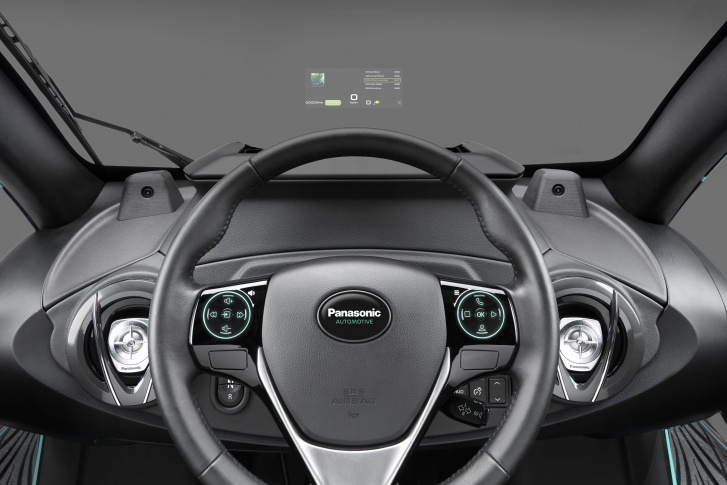Panasonic presents next-generation Augmented Reality Head-Up Display

Las Vegas, 5 January 2016
Panasonic is delighted to reveal its next-generation vehicle display system – technology that allows drivers to keep their eyes on the road and stay informed like never before.
Panasonic Automotive’s Head Up Display (HUD) with Augmented Reality (AR) is one of the world’s most sophisticated systems. It is capable of projecting very large virtual images in the driver’s eye line, using AR to enhance the real world with HUD-generated imagery. Combined, HUD with AR gives the driver more information and can warn him or her of potential dangers. It also replaces the traditional instrument cluster and with everything running through the HUD, many of the car’s traditional physical controls are replaced too.
With drivers subjected to many potential distractions on the move – from making Bluetooth phone calls to receiving dynamic satellite navigation instructions – Panasonic’s new HUD with AR seeks to simplify that workload by keeping the driver’s eyes where they should be: on the road.
Panasonic’s technology features a very compact HUD system, but one that it is capable of projecting very large virtual images – up to 12-degrees to the horizontal and 5-degrees to the vertical – into the driver’s visual path at a distance of 10m in front of the vehicle. Teamed with multiple around-vehicle cameras, the system brings unprecedented levels of visual information to the driver.
Augmented Reality technology means that this HUD can then be used to make the driver aware of potential dangers. Because the system recognizes objects in the path of the car, it can warn the driver by displaying alerts in the HUD, distinguishing between pedestrians, other vehicles and other objects, if they are potentially on a collision course.
The system uses a total of eight cameras: a rear camera, front camera, night vision camera, a down side view camera, two additional side view cameras and two cameras which track the driver’s head and eyes.
These cameras have many uses. The two cameras which constantly track the driver automatically adjust the HUD in real time so that the imagery is perfectly placed in his or her eye line. This means that movements of the driver’s head will result in updating the AR imagery so that they match and overlay real physical objects on the road.
The cameras also detect the side of the road and use this reference point to place the AR imagery in front of the driver. The cameras can also be combined to produce a variety of different views, including a bird’s eye view of the car, projected in the HUD to give the driver an a complete 360-degree top-down image. The cameras also negate the need for physical driving mirrors, with images projected in the HUD instead.
The system’s capability is so vast that it replaces not only the traditional instrument cluster but also many of the car’s physical controls. Panasonic’s demonstration vehicle features a modified interior that distills the HMI down to simplified steering wheel controls – paired with an integrated capacitive touch panel – completely replacing the car’s traditional stalks.
The system is then responsible for switching on and off the car’s indicators and its lights, notifying the driver via the HUD. The HUD itself is fully configurable and can show all information that would otherwise be displayed in the instrument cluster. Using the steering wheel controls and touch pad, the driver can change all settings via a menu visible on the HUD.
The overriding benefit of this system is that the HUD, making sure that the driver never has to take his or her eyes off the road, displays everything. The driver can also change the layout of the HUD to his or her preference – however if the system detects imminent danger, it will automatically switch to give special focus to warning information.
Demonstrated on a specially adapted Electric Vehicle, the technology can be applied to any new vehicle, while the whole system – from the HUD with AR to the eight cameras – runs from a single computer platform.
Andreas Heitmann, head of Panasonic’s Infotainment division in Europe, commented: “Every day on our roads, drivers are subjected to multiple distractions. At Panasonic we want to make the business of driving as enjoyable, safe and comfortable as possible, which is why we have developed this next-generation Head Up Display system.
“Paired with Augmented Reality and multiple cameras, its capability is enormous and it will make the lives of drivers much simpler and more enjoyable when behind the wheel. We’re very much looking forward to introducing this technology in the near future – watch this space.”
About Panasonic Automotive Systems Europe (PAISEU)
Panasonic Automotive & Industrial Systems Europe (PAISEU) provides electronic key components, components, modules and complete solutions to car manufacturers and automotive suppliers. Panasonic Automotive’s innovative systems and technologies help to make mobility safer, comfier, more enjoyable and environmentally-friendly, starting with infotainment systems, vehicle electronics, ADAS solutions through to batteries and technologies for electric mobility. Globally, Panasonic's Automotive & Industrial Systems is responsible for over one third of Panasonic’s overall revenue.